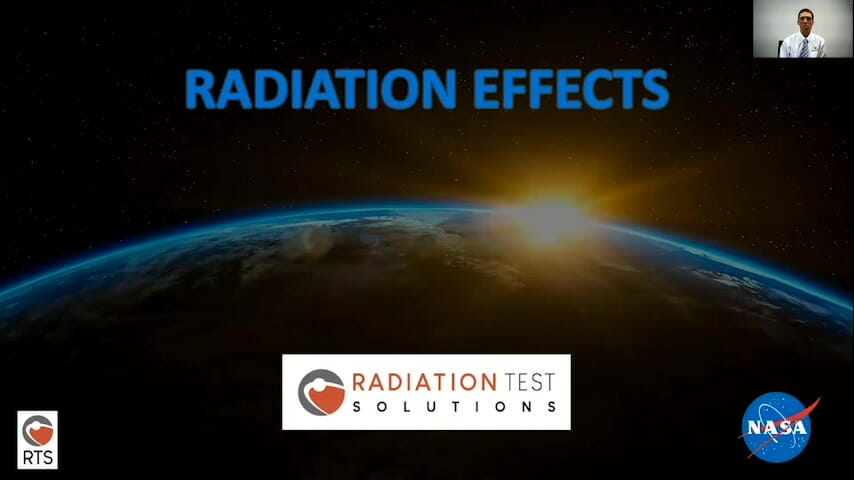Outside the protective cocoon of the Earth’s atmosphere is a universe full of radiation – it is all around us. Say the word “radiation” to three different people, and you’ll probably get three different reactions. Your aunt may tell you how radiation destroyed her cancer. Your neighbor might mention the “duck and cover” procedures of his day. And your comics-loving friend will explain how gamma rays turned Bruce Banner into The Hulk. Radiation comes in many forms and is all around us, all the time. But what is radiation?
Radiation is a form of energy that is emitted in the form of rays, electromagnetic waves, and/or particles. In some cases, radiation can be seen (visible light) or felt (infrared radiation), while other forms—like x-rays and gamma rays—are not visible and can only be observed with special equipment. Although radiation can have negative effects both on biological and mechanical systems, it can also be carefully used to learn more about each of those systems.
Space radiation is different from the kinds of radiation we experience here on Earth. Space radiation is comprised of atoms in which electrons have been stripped away as the atom accelerated in interstellar space to speeds approaching the speed of light – eventually, only the nucleus of the atom remains.
Space radiation is made up of three kinds of radiation: particles trapped in the Earth’s magnetic field; particles shot into space during solar flares (solar particle events); and galactic cosmic rays, which are high-energy protons and heavy ions from outside our solar system. All of these kinds of space radiation represent ionizing radiation.
Beyond Low Earth Orbit, space radiation may place astronauts at significant risk for radiation sickness, and increased lifetime risk for cancer, central nervous system effects, and degenerative diseases. Research studies of exposure in various doses and strengths of radiation provide strong evidence that cancer and degenerative diseases are to be expected from exposures to galactic cosmic rays (GCR) or solar particle events (SPE). Space based radiation can also effect the performance of electronic components and systems thereby jeopardizing the operation of a satellite, spacecraft or even critical life support systems our astronauts rely upon.
Milli-Sievert (mSv) is a form of measurement used for radiation. Astronauts are exposed to ionizing radiation with effective doses in the range from 50 to 2,000 mSv. 1 mSv of ionizing radiation is equivalent to about three chest x-rays. So that’s like if you were to have 150 to 6,000 chest x-rays. Electronic systems and components that are not specially engineered for this harsh environment will also likely have functional problems or, given enough time, fail altogether.
Radiation can be created by humans (microwaves, cell phones, radios, light bulbs, diagnostic medical applications such as x-rays) or naturally occurring (the Sun, radioactive elements in the Earth’s crust, radiation trapped in the Earth’s magnetic field, stars, and other astrophysical objects like quasars or galactic centers).
Earth’s biggest source of radiation is the Sun. The Sun emits all wavelengths in the electromagnetic spectrum (EM). The majority is in the form of visible, infrared, and ultraviolet radiation (UV). Occasionally, giant explosions, called solar flares, occur on the surface of the Sun and release massive amounts of energy out into space in the form of x-rays, gamma rays, and streams of protons and electrons. This is called a solar particle event (SPE). These solar flares can have serious consequences to astronauts and their equipment, even at locations that are far from the Sun.
Radiation can be either non-ionizing (low energy) or ionizing (high energy). Ionizing radiation consists of particles that have enough energy to completely removing an electron from its orbit, thus creating a more positively charged atom. Less energetic, non-ionizing radiation does not have enough energy to remove electrons from the material it crosses.
Examples of ionizing radiation include alpha particles (a helium atom nucleus moving at very high speeds), beta particles (a high-speed electron or positron), gamma rays, x-rays, and galactic cosmic radiation (GCR) from space. Examples of non-ionizing radiation include radio frequencies, microwaves, infrared, visible light, and ultraviolet (UV) light. While many forms of non-ionizing and ionizing radiation have become essential to our everyday life, each kind of radiation can cause damage to living and non-living objects, and precautions are required to prevent unnecessary risks.
While non-ionizing radiation is damaging, it can easily be shielded out of an environment as is done for UV radiation. Ionizing radiation, however, is much more difficult to avoid. Ionizing radiation has the ability to move through substances and alter them as it passes through. When this happens, it ionizes the atoms (knocks electrons out of them) in the surrounding material with which it interacts.
Ionizing radiation is like an atomic-scale cannonball that blasts through material, leaving significant damage behind. More damage can also be created by secondary particles that are propelled into motion by the primary radiation particle. Imagine what this can do to the electronics in a typical computer. Those cannonballs can change the contents of memory or the ability of the processor to properly perform a task.
The particles associated with ionizing radiation in space are categorized into three main groups relating to the source of the radiation: galactic cosmic rays, solar flare particles, and radiation belt particles (Van Allen Belts) trapped in space around the Earth.
Galactic Cosmic Radiation (GCR) is a dominant source of radiation that must be dealt with aboard current spacecraft and future space missions within our solar system. GCR comes from outside the solar system but primarily from within our Milky Way galaxy. GCR is composed of the nuclei of atoms that have had their surrounding electrons stripped away and are traveling at nearly the speed of light. Another way to think of GCR would be to imagine the nucleus of any element in the periodic table from hydrogen to uranium. Now imagine that same nucleus moving at an incredibly high speed. The high-speed nucleus you are imagining is GCR. These particles were probably accelerated within the last few million years by magnetic fields of supernova remnants.
In summary, GCR are heavy, high-energy ions of elements that have had all their electrons stripped away as they journeyed through the galaxy at nearly the speed of light. They can cause atoms they pass through to ionize. They can pass practically unimpeded through a typical spacecraft, including its sensitive electronics, or the skin of an astronaut.
Yes, but not entirely. Life on Earth is protected from the full impact of solar and cosmic radiation by the magnetic fields that surround the Earth and by the Earth’s atmosphere. The Earth also has radiation belts caused by its magnetic field. The inner radiation belt, or Van Allen Belt, consists of ionizing radiation in the form of very energetic protons—by-products of collisions between GCR and atoms of Earth’s atmosphere. The outer radiation belts contain protons and electrons. As we travel farther from Earth’s protective shields we are exposed to the full radiation spectrum and its damaging effects.
In addition to a protective atmosphere, we are also lucky that Earth has a magnetic field. It shields us from the full effects of the solar wind and GCR. Without this protection, Earth’s biosphere might not exist as it does today, or would at least be limited to the subsurface.
There are three main factors that determine the amount of radiation that astronauts receive or how radiation affects astronauts.




